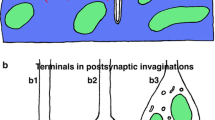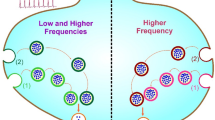Abstract
We have compared the distribution of vesicles in amphibian motor nerve terminals determined by electron microscopy and by functional labeling with the styryl dye, FM2-10. Our aim was to resolve apparent discrepancies in the literature on the distribution of vesicles determined by the two procedures. Electron photomicrographs of non-serial cross sections of terminal branches were analyzed by stereological procedures to obtain indices of the terminal and vesicle areas. Terminal cross sectional area varied 3-fold on average along terminal branches and was largest particularly when active zone was present in the section. The vesicle area index (a measure of vesicle abundance) was highly correlated with the terminal area index, suggesting that the average density of vesicles is constant throughout the branches. When the data were separated according to whether active zone was present or not in a section, we found a small (26%) but significant increase in the average density of vesicles in active zone compared with non-active zone regions in the terminal. The distribution of spots along terminal branches following vesicle staining with FM2-10, as well as with antibodies to vesicle proteins, suggested that vesicles were distributed in highly concentrated clusters. However, the degree of variation between spot and inter-spot staining intensities found with the FM-dye was similar in magnitude to that for terminal cross sectional area determined from the electron microscopy. We conclude that the spotty pattern of stained vesicles seen with the optical microscope results primarily from vesicle accumulations associated with terminal varicosities.
Similar content being viewed by others
References
Betz, W. J. & Bewick, G. S. (1993) Optical monitoring of transmitter release & synaptic vesicle recycling at the frog neuromuscular junction. Journal of Physiology (London) 460, 287-309.
Betz, W. J., Bewick, G. S. & Ridge, R. M. (1992a) Intracellular movements of fluorescently labeled synaptic vesicles in frog motor nerve terminals during nerve stimulation. Neuron 9, 805-813.
Betz, W. J., Mao, F. & Bewick, G. S. (1992b) Activity-dependent fluorescent staining & destaining of living vertebrate motor nerve terminals. Journal of Neuroscience, 12, 363-375.
Betz, W. J. & Henkel, A. W. (1994) Okadaic acid disrupts clusters of synaptic vesicles in frog motor nerve terminals. Journal of Cell Biology 124, 843-854.
Birks, R., Huxley, H. E. & Katz, B. (1960) The fine structure of the neuromuscular junction of the frog. Journal of Physiology (London) 150, 134-144.
Ceccarelli, B., Hurlbut, W. P. & Wauro, A. (1973) Turnover of transmitter and synaptic vesicles at the frog neuromuscular junction. Journal of Cell Biology 57, 499-524.
Colasante, C. & Pecot-Dechavassine, M. (1996) Ultrastructural distribution of synaptophysin & synaptic vesicle recycling at the frog neuromuscular junction. Journal of Neuroscience Research 44, 272-282.
D'Alonzo, A. J. & Grinnell, A. D. (1985) Profiles of evoked release along the length of frog motor nerve terminals. Journal of Physiology (London) 359, 235-258.
Dunaevsky, A. & Connor, E. A. (2000) F-Actin is concentrated in nonrelease domains at frog neuromuscular junctions. Journal of Neuroscience 20, 6007-6012.
Everett, A. W., Packard, S. J., Cosby, M. & Milne, R. K. (1999) Membrane recycling due to low and high rates of nerve stimulation at release sites in the amphibian (Bufo marinus) neuromuscular junction. Synapse 32, 110-118.
Harris, K. M. & Sultan, P. (1995) Variation in the number, location and size of synaptic vesicles provides an anatomical basis for the nonuniform probability of release at hippocampal CA1 synapses. Neuropharmacology 34, 1387-1395.
Henkel, A. W., Simpson, L. L., Ridge, R. M. A. P. & Betz, W. J. (1996) Synaptic vesicle movements monitored by fluorescence recovery after photobleaching in nerve terminals stained with FM1-43. Journal of Neuroscience 16, 3960-3967.
Herrera, A. A., Grinnell, A. D. & Wolowske, B. (1985) Ultrastructural correlates of naturally occurring differences in transmitter release efficacy in frog motor nerve terminals. Journal of Neurocytology 14, 193-202.
Heuser, J. E. & Reese, T. S. (1973) Evidence for recycling of synaptic vesicle membrane during transmitter release at the frog neuromuscular junction. Journal of Cell Biology 57, 315-344.
Karnovsky, M. J. & Roots, L. (1964) A “directcolouring” thiocholine method for cholinesterase. Journal of Histochemistry and Cytochemistry 12, 434-444.
MacLeod, G. T., Gan, J.-B. & Bennett, M. R. (1999) Vesicle-associated proteins and quantal release at single active zones of amphibian (Bufo marinus) motor-nerve terminals. Journal of Neurophysiology 82, 1133-1146.
MacLeod, G. T., Khurana, V., Gibson, W. G. & Bennett, M. R. (1998) Probability of quantal secretion and the mobilization of vesicles at the active zones of endplates. Journal of Theoretical Biology 191, 323-334.
Mikoshiba, K., Fukuda, M., Moreira, J. E., Lewis, F. M. T., Sugimori, M., Niinobe, M. & Llinas, R. (1995) Role of theC2Adomain of synaptotagmin in transmitter release as determined by specific antibody injection into the squid giant synapse preterminal. Proceedings of the National Academy of Sciences, USA 92, 10703-10707.
Pawson, P. A., Grinnell, A. D. & Wolowske, B. (1998) Quantitative freeze-fracture analysis of the frog neuromuscular junction synapse-I. Naturally occurring variability in active zone structure. Journal of Neurocytology 27, 361-377.
Pierce, J. P. & Mendell, L. M. (1993) Quantitative ultrastructure of Ia boutons in the ventral horn: Scaling and positional relationships. Journal of Neuroscience 13, 4748-4763.
Pieribone, V. A., Shupliakov, O., Brodin, L., Hilfiker-Rothenfluh, S., Czernik, A. J. & Greengard, P. (1995) Distinct pools of synaptic vesicles in neurotransmitter release. Nature 375, 493-496.
Propst, J. W. & Ko, C.-P. (1987) Correlations between active zone ultrastructure and synaptic function studied with freeze-fracture of physiologically identified neuromuscular junctions. Journal of Neuroscience 7, 3654-3664.
Renger, J. J., Egles, C. & Liu, G. (2001) Adevelopmental switch in neurotransmitter flux enhances synaptic efficacy by affecting AMPA receptor activation. Neuron 29, 469-484.
Richards, D. A., Guatimosim, C. & Betz, W. J. (2000) Two endocytotic recycling routes selectively fill two vesicle pools in frog motor nerve terminals. Neuron 27, 551-559.
Ryan, T. A. (1999) Inhibitors of myosin light chain kinase block synaptic vesicle pool mobilization during action potential firing. Journal of Neuroscience 19, 1317-1323.
Schikorski, T. & Stevens, C. F. (1997) Quantitative ultrastructural analysis of hippocampal excitatory synapses. Journal of Neuroscience 17, 5858-5867.
Turner, K. M., Burgoyne, R. D. & Morgan, A. (1999) Protein phosphorylation & the regulation of synaptic membrane traffic. Trend in Neurosciences 22, 459-464.
Weibel, E. R. (Ed.) (1979) Stereological Methods, Vol. 1, London,NewYork, Toronto, Sydney, San Francisco: Academic Press.
Wu, L.-G. & Betz, W. G. (1999) Spatial variability in release at the frog neuromuscular junction measured with FM1-43. Canadian Journal of Physiology and Pharmacology 77, 672-678.
Xu, T. & Bajjalieh, S. M. (2001) SV2 modulates the size of the readily releaseable pool of secretory vesicles. Nature Cell Biology 3, 691-698.
Yeow, M. B. L. & Peterson, E. H. (1991) Active zone organization & vesicle content scale with bouton size at a vertebrate central synapse. Journal of Comparative Neurology 307, 475-486.
Author information
Authors and Affiliations
Rights and permissions
About this article
Cite this article
Everett, A.W., Edwards, S.J. & Etherington, S.J. Structural basis for the spotted appearance of amphibian neuromuscular junctions stained for synaptic vesicles. J Neurocytol 31, 15–25 (2002). https://doi.org/10.1023/A:1022515430224
Issue Date:
DOI: https://doi.org/10.1023/A:1022515430224




